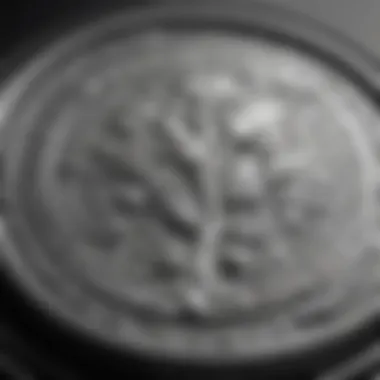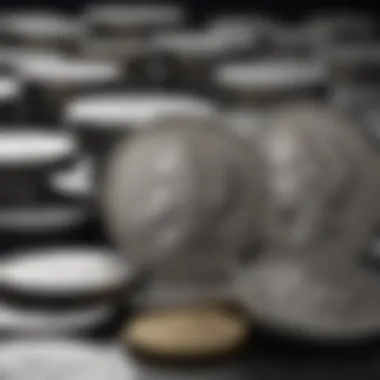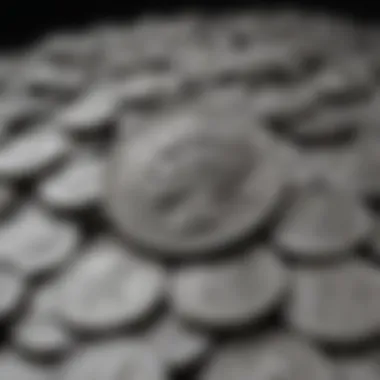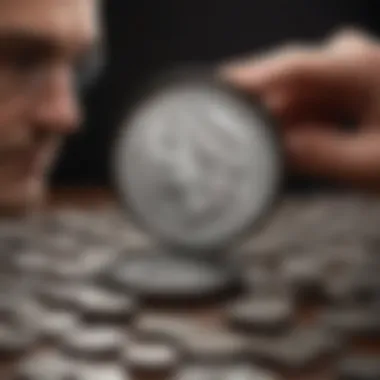Understanding Silver Dollar Coins and Their Worth


Intro
The world of silver dollar coins is as rich and multifaceted as it gets, much like an intricate tapestry woven over the years. From historical anecdotes to their significant role in today's financial landscape, these coins hold value beyond mere metal. Recognizing their worth involves navigating through various factors that influence market trends, their historical context, and, crucially, the preferences of both collectors and investors. This journey not only informs decisions but also enhances the appreciation for these remarkable pieces of currency.
As we tread further into this topic, it's essential to ground our discussion with a firm grasp of investment terminology, ensuring that every reader, regardless of expertise, can grasp the nuances involved. What does it mean when you hear terms like "numismatics" or "spot price" thrown around? This guide aims to peel back those layers, and much more, to reveal a comprehensive understanding of silver dollar coins in the marketplace and beyond.
Prelude to Silver Dollar Coins
When delving into the world of numismatics, silver dollar coins often steal the show. Their unique historical significance and the evolving dynamics of their value make these coins a subject of interest for collectors and investors alike. Understanding silver dollar coins goes beyond mere aesthetics; it taps into economic history, cultural relevance, and market trends.
In this article, we will explore various aspects related to silver dollar coins. From their historical context to their importance in numismatics, it is essential to grasp what makes these coins valuable. Not only do they reflect a piece of American history, but they also present opportunities for investment and collection satisfaction.
Focusing on silver dollar coins allows enthusiasts to discern differences in varieties, grading, and market sentiments. Thus, whether you’re a seasoned collector or a budding financial enthusiast, there’s valuable insight to be gleaned on how to navigate the world of silver dollars.
Historical Context
Silver dollar coins have a rich history that echoes through the ages. These coins were originally minted in the United States in the late 18th century, primarily to facilitate trade and commerce. The first silver dollar, the Flowing Hair Dollar, made its debut in 1794, setting the stage for many varieties that would follow.
Throughout the 19th century, silver dollar coins gained prominence amidst the backdrop of the mining boom in the West. Picture miners digging tirelessly for silver, their finds culminating in beautifully minted coins that became symbols of prosperity and wealth. The Morgan Silver Dollar, introduced in 1878, embodies this spirit and remains one of the most beloved and collected coins in the U.S. history.
"These coins tell stories of struggle, ambition, and the quest for fortune."
Moreover, the introduction of the Peace Silver Dollar in the early 20th century marked a shift in tone, with designs reflecting the nation’s hopes for peace following World War I. This historical context not only provides insights into the coins themselves but also offers a glimpse into the societal values of that era, making them infinitely more than mere collectibles.
Significance in Numismatics
In numismatics, the study of coins and currency, silver dollar coins hold a significant place. Their value is often bolstered by rarity, demand, and historical appeal. Each coin is a tangible representation of a time period, social changes, and economic transactions. For collectors, owning a silver dollar is akin to holding a piece of history, a small but mighty artifact that represents more than just its intrinsic metal value.
Additionally, the grading system in numismatics plays a crucial role in determining a silver dollar’s worth. Coins can range from "Good" to "Mint State" condition, significantly impacting their market price. Understanding the grading system is vital for anyone interested in acquiring or selling these coins. It allows buyers and sellers to make informed decisions based on condition, rarity, and market data.
In short, silver dollar coins are not simply currency; they are gateways into the past and opportunities for the future. Their unique significance in the world of numismatics cannot be overstated.
Types of Silver Dollar Coins
Understanding the various types of silver dollar coins is vital for collectors and investors alike. Each type carries its own significance, historical context, and varying degrees of market value. Knowing the nuances among these coins can make a difference not just in appreciation of their craftsmanship but also in making informed buying or selling decisions. The characteristics that define each type, such as design, minting period, and rarity, are essential elements for anyone wanting to delve deeper into the world of silver dollar coins.
Morgan Silver Dollar
The Morgan silver dollar, minted from 1878 to 1904 and then again in 1921, is perhaps one of the most recognizable silver coins in American history. Designed by George T. Morgan, this coin features Lady Liberty on the obverse and an eagle on the reverse. Its undeniable beauty and the intricate detail of the design have made it a favorite among collectors.
When it comes to market value, the Morgan silver dollar is influenced by various factors, such as mint mark, year of minting, and overall condition. A coin with a CC mint mark from the Carson City Mint, for instance, generally fetches a premium due to its limited mintage. Early coins in uncirculated grade can command prices that are much higher compared to their counterparts from later years or lower grades.
Collectors often seek specific varieties of the Morgan, like the 1893-S, known for its low mintage, thereby increasing demand and value. Owning a Morgan silver dollar goes beyond mere investment; it’s a connection to America’s past.
Peace Silver Dollar
Next on the list is the Peace silver dollar, minted from 1921 to 1935. Designed by Anthony de Francisci, this coin was created to commemorate the end of World War I. The Peace dollar features a serene depiction of Lady Liberty and an eagle, symbolizing peace and hope.
The worth of the Peace silver dollar revolves around its historical significance and condition. While their value is typically lower than that of Morgan dollars, rare dates, such as the 1928, can see substantial valuations in high grades. Condition plays a crucial role here as well. A well-preserved coin can sometimes double the price of one that is heavily worn.
This series also appeals to those interested in the symbolic evolution of American coinage during a turbulent historical period.
Eisenhower Dollar
Minted from 1971 to 1978, the Eisenhower dollar serves as a representation of both the Vietnam War era and the burgeoning space race. With a larger diameter than preceding silver dollars, it features President Dwight D. Eisenhower on the obverse and an image of the Apollo 11 mission's lunar landing on the reverse.
In comparison to older silver dollar types, the value of the Eisenhower dollar is generally lower since it was produced in larger quantities. However, the coin is still of interest to collectors, particularly those who focus on error coins or specific minting imperfections. The silver-clad versions, which contain 40% silver, have a premium value over their copper-nickel counterparts, leading collectors to consider these coins not just as currency, but as a part of history.


Other Variants
Beyond the Morgan, Peace, and Eisenhower silver dollars, there exist several other variants worth mentioning. The Silver American Eagle series has been released annually since 1986 and is popular among investors due to its consistent silver content (one ounce of .999 silver) and government backing. Collectors might also explore lesser-known coins like the Trade dollar, historically used in commerce with East Asia during the late 19th century.
Each variant carries unique characteristics that can impact their market appeal. Variations in mint marks, specific designs, and historical significance should guide a collector’s focus when assessing or acquiring coins. Keeping an eye on emerging trends helps enthusiasts understand better what drives the market for these silver dollars.
"The beauty of silver dollar coins not only lies in their composition but in their intertwined narratives throughout American history."
Determining the Worth
Understanding how to determine the value of silver dollar coins is crucial for anyone involved in numismatics or even just dipping their toes into coin collecting. The worth of these coins is not merely dictated by their age or popularity; rather, it involves a nuanced interplay of several factors. Grasping the importance of this topic leads to not only a better appreciation of the coins themselves but also provides insightful guidance for both collectors and investors.
Many enthusiasts fall into the trap of oversimplifying the valuation process, thinking that rarity alone should dictate worth. However, it’s much more complex than that. Factors like metal content, the condition of the coin, and current market dynamics significantly influence the price, and understanding these elements can make a world of difference in making informed decisions.
Metal Content Analysis
When discussing silver dollar coins, the first major factor to consider is metal content. The most recognized silver dollar coins, like the Morgan and Peace dollars, are made primarily of silver. A good starting point for assessing their value starts with the intrinsic value of the metal itself.
For example, a Morgan dollar contains about 0.7734 troy ounces of pure silver. If the current market price of silver is around $25 per ounce, the coin’s base value linked to its metal content is roughly $19.34. Naturally, this value can fluctuate as silver prices change, so keeping a finger on the market pulse is important.
Yet, it doesn't stop at the amount of silver. Coin production errors and specific dates can also create anomalies in value, making it important to reference reliable sources for current melt values, such as Kitco or Coinflation.
Condition and Grading
Next up is the condition and grading of the coin, which is pivotal in determining its market value. Coins are graded based on their physical state, typically following the Sheldon Scale, which ranges from 1 (poor) to 70 (perfect). For silver dollars, one could easily find significant value difference based on grading alone.
- Good (G) through Very Good (VG) – Coins in these grades show wear but are identifiable. Generally, they don’t attract high prices.
- Fine (F) – Moderate wear with some detail in the design still visible. This state offers a slight increase in value.
- Very Fine (VF) – Clear design details and minimal wear; often considered a collector's favorite.
- Extremely Fine (XF) – Coins that show very little wear, commanding solid premiums.
- Uncirculated (MS) – Coins that have not been circulated, hoarding much of their original luster command the highest prices on the market.
Investors and collectors ought to familiarize themselves with these grading nuances. A seemingly minor difference in condition could mean the difference between a few dollars and several hundred or even thousand.
Market Demand and Trends
Finally, one cannot overlook the market demand and trends. Sometimes, the story behind a coin dictates its worth even more than its physical attributes. For instance, if a particular series of coins sees a surge in interest among collectors, prices tend to climb.
Awareness of broader economic indicators can also impact market behavior. For example, during economic downturns, precious metals—such as silver—often retain or even gain value as they are viewed as safe-haven assets. Keeping a watchful eye on price trends helps coin enthusiasts make scientifically-backed decisions whether to buy or sell.
Even social media platforms, such as Facebook groups or subreddits on Reddit, allow collectors to track shifts in interest and demand for specific types of coins. Being part of the community fosters insights that can be enlightening and, frankly, lucrative.
With this knowledge in hand, anyone venturing into the world of silver dollars can now approach the task of determining their worth with increased confidence and informed strategies.
Market Influences on Value
The market for silver dollar coins is as intricate as a spider's web, with various factors converging to shape the overall worth of these prized pieces. Understanding these influences is paramount for collectors and investors alike. The value of silver dollar coins doesn't merely hinge on their metal content or historical significance; instead, it's a complex dance of economic indicators, community interests, and the results of recent auctions that define their market appeal.
Economic Indicators
Economic indicators play a crucial role in defining the value of silver dollar coins. Think of it as the weather report for the economy—when the forecast looks gloomy, many turn to precious metals, including silver, as a safe haven. Factors like inflation rates, currency fluctuations, and even shifts in the stock market can all impact demand for silver dollar coins. Here are key economic indicators to consider:
- Inflation Rate: When inflation rises, the value of currency dips, driving more investors toward precious metals.
- Interest Rates: Higher interest rates often pull investors towards bonds and other interest-bearing assets, potentially decreasing demand for coins.
- Stock Market Trends: A bullish stock market might reduce interest in collectibles as investors chase higher returns elsewhere, but bear markets usually have the opposite effect.
It’s important to keep an eye on these indicators. For example, during the 2008 financial crisis, gold and silver prices surged due to increased demand for safe assets. Those with foresight in collecting silver dollar coins found their investments appreciated significantly.
Collector Communities
Collector communities are vital to the ecosystem surrounding silver dollar coins. These groups often dictate trends, prices, and overall market enthusiasm. Social media platforms and forums, like Reddit and Facebook, foster discussions and enable collectors to exchange tips, historical anecdotes, and market insights.
The sense of community greatly influences demand. When a particular coin gains popularity in these circles, whether due to a historical anniversary or a notable auction result, its value can shoot up overnight. Considerations for collector communities include:
- Online Forums: Engaging in discussions helps collectors gauge current trends and values.
- Specialized Groups: Joining groups with like-minded individuals can provide insider knowledge on rare coins or upcoming events.
- Conventions and Shows: Attending numismatic events can connect you with experts and deepen one’s understanding of the market.


Being part of these communities not only fuels one’s passion but can lead to valuable networking that increases one's knowledge of silver dollar coins.
Recent Auction Results
The outcomes of recent auctions can act as a litmus test for the market, showcasing what buyers are currently willing to pay for specific silver dollar coins. Auction houses, like Heritage Auctions or Stack's Bowers, often see records shattered when rare coins are sold, sending ripples through the community and altering values significantly.
When evaluating recent auction results, look for:
- Record Sales: High sale prices of specific coins can boost the perceived value of similar items.
- Market Saturation: If many coins of a particular type are being sold, this could lower prices as supply outstrips demand.
- Rarity and Condition: Unique coins with provenances or those in exceptional condition often fetch top dollar, influencing market trends.
"Rare coins can often appreciate like fine art, but they sometimes require a bit of intuition and timing to realize their potential."
Understanding how these three market influences interplay offers significant insight into the silver dollar coin market. As trends and economic circumstances evolve, so too will the landscape for collectors and investors.
Buying Silver Dollar Coins
Understanding the process of buying silver dollar coins is crucial for collectors and investors alike. Entering the market without a clear path can be daunting, but it doesn’t have to break the bank or the spirit. This section outlines key elements and considerations, ensuring that you’re well-equipped to make informed decisions when acquiring these valuable pieces of history.
Where to Purchase
When it comes to buying silver dollar coins, knowing where to look is half the battle. Here are several places where you can source these coins:
- Coin Shops: Local coin shops often have a selection of silver dollars available. Benefits include the opportunity to inspect the coins in person, which allows for a better assessment of their condition.
- Estate Sales and Auctions: Sometimes, hidden treasures can be found at estate sales or local auctions. It's a mixed bag; you never know what you’re going to find, but the thrill is part of the chase!
- Online Marketplaces: Websites like eBay can be a goldmine for silver dollar collectors, but buyer beware – you need to do your research on the seller's reputation and the authenticity of the coins.
- Mints and Authorized Dealers: Buying directly from the United States Mint or authorized dealers guarantees authenticity. However, pricing may be higher compared to other avenues.
Online vs Physical Dealers
Deciding between online and physical dealers involves weighing convenience against assurance.
Online Dealers
- The most significant advantage is convenience; you can shop from the comfort of your couch. However, it’s vital to ensure you’re purchasing from reputable sites. Some known names in the biz include APMEX and JM Bullion.
- Buyer reviews can reveal the reliability of online dealers, so be sure to do your homework.
Physical Dealers
- In contrast, physical dealers offer the tangible experience of inspecting your potential purchase. You can touch, feel, and even ask questions about each coin.
- The human interaction can provide a layer of trust that online transactions often lack. Plus, bartering in person can lead to better prices if you know what you’re talking about.
Tips for Beginners
If you’re just starting your journey in the world of silver dollar coins, here are some handy tips that can ease the learning curve:
- Do Your Research: Familiarize yourself with the different types of silver dollar coins, their histories, and their current market values. Books, articles, and reputable numismatic websites are a great start.
- Set a Budget: It’s easy to get carried away, but knowing your financial limits from the outset will help you make more rational decisions.
- Join a Community: Engaging with fellow collectors can provide an invaluable wealth of knowledge and support. Websites like Reddit have vibrant communities where you can ask questions and get advice.
- Be Patient: The right coin for your collection will come along. There's no need to rush; if you wait, you might find a gem at a better price.
- Look for Authenticity Guarantees: Whether buying online or from a physical dealer, ask for certificates or any form of authentication to protect your investments.
In summary, buying silver dollar coins requires a bit of savvy and a dash of patience. By considering your options wisely and educating yourself, you'll enhance your chances of not just making a purchase, but making a smart one.
Selling Silver Dollar Coins
Selling silver dollar coins carries its own weight, both literally and metaphorically. For collectors and investors, knowing when and how to sell these pieces is crucial in maximizing returns. This section of the article digs into three essential components of the selling process: selecting the optimal time to sell, crafting effective strategies for a successful transaction, and finally, evaluating offers to ensure you’re getting a fair deal.
Choosing the Right Time
Time is often the silent partner in any selling strategy. Understanding when to sell can profoundly affect the overall outcome. If one aims to make a neat profit, it’s essential to pay attention to market trends, historical sales data, and economic indicators.
- Market fluctuations: Silver dollar coins have endured various market cycles, often spurred by broader economic conditions. Keeping an eye on the spot price of silver can give a solid indication of the coin’s potential value.
- Seasonal demand: Certain times of the year may witness higher collector interest. Holidays or specific events might prompt enthusiasts to acquire new pieces. Timing your sale around these periods can yield better results.
- External factors: News articles, auction results, or significant market shifts might influence appetite for purchasing coins. Following numismatic forums and websites like reddit.com or dedicated Facebook groups can keep you in the loop about what's generating buzz.
Effective Selling Strategies
Once you’ve pinpointed the right moment, having a solid strategy in place can seal the deal. Here are some effective tactics:


- Presentation matters: Display your coins professionally. Consider having them graded by a reputable grading service. Well-preserved coins can fetch a noticeably higher price than their less appealing counterparts.
- Utilize online platforms: Websites like eBay are treasure troves for selling coins. With a proper description and clear images, listings can attract buyers from all corners. In addition, consider niche websites focused on numismatics.
- Networking: Engage with local coin dealers or participate in coin shows. Building a rapport with these individuals can sometimes lead to better offers. They’re often willing to pay premium prices for coins they think can sell quickly.
Evaluating Offers
When it comes to selling, not all offers are created equal. Learning how to assess offers effectively can help you avoid leaving money on the table.
- Research comparable sales: Look into recent auction results to get a sense of what similar coins have sold for. This will give you a baseline for negotiating.
- Trust your instincts: If an offer seems off, don’t hesitate to decline. A too-good-to-be-true deal often is just that. Keep an air of skepticism; it can be beneficial in the long run.
- Consider more than just the price: Sometimes, offers that seem lower can include perks like ease of transaction or immediate payments. Think about what fits your needs and weigh those factors accordingly.
"In the world of numismatics, the golden rule is not just about the coins themselves but understanding the marketplace in which they exist."
Selling silver dollar coins is not just a transaction; it's a balancing act of timing, strategy, and decision-making. By mastering each element, whether it's choosing the right moment, implementing effective selling strategies, or accurately evaluating offers, you will enhance your experience and potential returns in this intriguing world of coin collecting.
Future of Silver Dollar Coins
The future of silver dollar coins is a topic packed with nuances that hold significant weight for both collectors and investors alike. As time moves forward, understanding the projected trajectories of these coins can give crucial insights to those involved in the numismatic sphere. Factors such as investment potential, market trends, and the evolving role of these coins in collecting communities will be examined closely.
Investment Potential
Silver dollar coins present a fascinating investment opportunity, having shown resilience over the years. The appeal lies not just in their metal composition, but also in their historical relevance and aesthetic qualities. Investors often view these coins as a hedge against inflation, with their intrinsic value fluctuating with market conditions.
Key considerations include:
- Metal Content: The primary value for many investors comes from the silver content itself. As the price of silver rises or falls, the valuation of the coins often follows suit.
- Rarity and Demand: Some silver dollars have become exceptionally rare. Morgan and Peace Dollars, for instance, are highly sought after, which can significantly increase their market price.
- Long-term Trends: Historically, silver has been a good store of value. Investors may want to consider looking into historical trends in silver prices to make informed decisions.
In essence, silver dollar coins represent a meld of nostalgia and financial opportunity, drawing in those who appreciate both history and profit.
Predicted Market Trends
Like any investment market, the silver dollar coin market is subject to cycles influenced by broader economic indicators. Observing these trends can provide insight into where the market may be headed.
Several notable trends include:
- Increased Interest from Millenials: There is a growing trend among younger collectors and investors taking an interest in tangible assets. Silver dollar coins could appeal to this demographic as they often seek a balance between investment and collectibles.
- Digital Collecting: With the advent of the digital age, many collectors are turning to platforms that offer trading and auctions online. This shift can lead to greater visibility and accessibility of silver dollar coins, potentially increasing demand.
- Sustainability and Ethical Considerations: As societal values evolve, there’s an increasing focus on ethical investing and sourcing practices in the precious metals market. Coins that have a story or principle behind their collection may see an uptick in popularity.
Encouragingly, the overall sentiment remains optimistic, spurred by the intrinsic allure of these historical pieces.
Role in Collecting
The role of silver dollar coins within the collecting community can’t be understated. They serve as more than just currency; they are artifacts that embody rich stories and cultural significance. For many, the collection of these coins is a passion that connects them to history and community.
A breakdown of their role includes:
- Cultural Artifact: Silver dollars represent eras gone by, reflecting the artistry and values of the times they were minted.
- Community Building: Collectors often share resources and insights through online communities such as those found on platforms like Reddit and Facebook, providing a space to discuss findings and trends.
- Investment Education: Collecting silver dollars can also serve as an entry point for learning about investment strategies, metals markets, and even economics in general.
"Collecting silver dollar coins is not merely about ownership; it’s about understanding history, investing wisely, and connecting with like-minded individuals."
Epilogue
In wrapping up our exploration of silver dollar coins, we underscore the significance of understanding their value beyond mere monetary assumptions. This article has walked through historical aspects and varying types of silver dollars, shedding light on essential factors that contribute to their worth in today’s market.
Recap of Key Insights
To reiterate, silver dollar coins are not just collectible items; they carry rich stories of the era they were minted in. Key points we’ve covered include:
- Historical Significance: Each coin tells a tale rooted in U.S. history, reflecting the economic climate during its minting period. The Morgan and Peace dollars, for example, portray pivotal moments and shifts.
- Market Demand Influences: The value is significantly affected by economic conditions, collector interests, and recent auction results. For instance, a rare Morgan silver dollar can command a price that far exceeds its face value.
- Evaluation Factors: Condition and grading are vital when appraising these coins. Coins in mint condition fetch a higher price compared to their worn-out counterparts.
- Future Trajectories: Understanding investment potential can guide future purchases or sales. The consensus on trends suggests that, despite fluctuations, a growing interest in precious metals may provide a buffer against economic challenges.
This understanding is critical for anyone looking to collect or invest in silver dollar coins, ensuring they are both informed and prepared when navigating this niche market.
Encouragement for Further Research
As we draw this discussion to a close, there’s always room for deeper inquiry. The world of numismatics is ever-evolving, and each coin has a unique narrative waiting to be unraveled. Here are some paths for exploration:
- Join Online Forums: Platforms like Reddit offer vibrant communities where collectors exchange insights and share experiences about buying, selling, and evaluating coin collections.
- Leverage Academic Resources: Websites like Britannica provide comprehensive articles on the history of coins and their economic implications.
- Engage in Local Coin Shows: Attending events not only expands one’s knowledge but also helps in connecting with fellow enthusiasts and potential mentors.
"Knowledge is the beginning of all wisdom. Keep seeking it in every coin you encounter."







